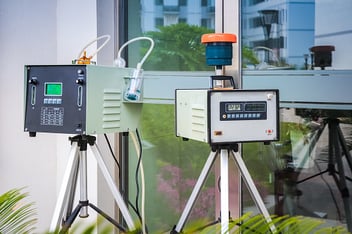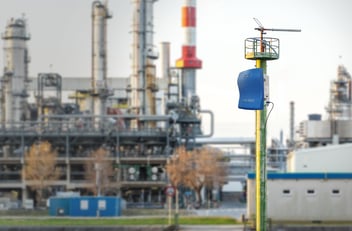How to Buy Air Pollution Control Equipment for Indoor Commercial Areas
The sources of air pollution are essentially linked with how we live in cities. Air pollution in Indian cities has harmful effects on both indoor and ambient air pollution. So what is IAQ? Indoor Air Quality (IAQ) means the air quality within and around building structures, especially as it relates to the health and comfort of building occupants. Understanding and controlling common pollutants indoors can help reduce the risk of indoor health concerns. This article aims to answer all the relevant questions regarding indoor air pollution, the current situation, the need for air purifiers for cleaning indoor air in large enclosed spaces, and solutions.
The Need for Air Purifiers for Indoor Air:
The air indoors has proven to be more harmful than the air outdoors. Awareness of indoor air components is the first step toward understanding the need for indoor air cleaner.
So, which material is a common indoor air pollutant?
Indoor air comprises particles like dust mites, pollens, carbon fibers, pet dander, and chemicals such as VOCs (Volatile Organic Compounds) from paints and varnishes, smoke, and cooking odors.
Air pollution control devices cater to our daily share of breathable air. Air purifiers use the latest clean air technology and mechanical processes to withdraw various harmful pollutants like PM 10 and PM 2.5 pollutants from the air. The clean air is then circulated again into the atmosphere, making it fresh and breathable. This equipment purifies the air, making it free of harmful pollutants and neutralizing unpleasant odors, ensuring better sleep and a healthy lifestyle.
Effects of Air Pollution on the Human Body:
High Quality of environment is necessary. Pollutants present in indoor air may cause dust allergies, asthma, and other respiratory disorders. Prolonged exposure to indoor air pollution harms our lives. It leads to hampered productivity at work, and children's performance at school where they tend to feel lethargic after being exposed to polluted air for long which may lead to absenteeism, and a greater impact on education is perhaps observed.
We also overlook the usage of very basic items and devices at home that contribute the most to polluting indoor air quality. Commonly used products such as inkjet printers and cleaning agents deteriorate ambient air quality with every use. The effects of which can reflect in our health after a certain period.
Benefits of Air Purifiers:
The purpose of air purifiers serves a great deal in promoting much more than just health benefits. Air Pollution is responsible for the severe effects observed on our mental health, physical health, financial and spiritual health, and any one of these leads to the other. By ascertaining polluted air as the reason behind our draining energy and low performance in our daily activities, we step closer to making significant changes and witnessing growth in many aspects of life.
Why Use an Air Purifier?
Breathing fresh air reduces stress, anxiety, and other depressive disorders. Daily use of purifiers provides a long-term impact on human health. We notice greater profits and get accredited for our improved performance.
The inclusion of Air purifiers in large working areas such as offices, factories, and industries promote a positive working environment, healthy office space, better productivity of employees, and increased profits. It reduces the possibility of air-borne diseases and protects the lungs from harmful pollutants such are PM10 and PM2.5 and prevents allergies and respiratory disorders.
Types of Air Purifiers:
There are different air purifier types available on the market. All of them have a distinct type of requirement, some come with different types of air filters with particular period of filter replacement, and the others with a maintenance cost. Let’s delve into the details of different kinds of Air Purifiers.
There are three broad categories of air purifiers available in the market:
Standalone Air Purifiers:
HEPA Air Purifiers:
High-Efficiency Particulate Arrestors or HEPA air purifiers are mechanical filters that clean allergens like pollen, animal skin, and dander. They use UVC to sterilize air.
Ozone Air Purifiers:
Ozone Air Purifiers produce Ozone gas that helps deactivate bacteria, viruses, and other harmful microorganisms. However, Ozone is a greenhouse gas, and even a little exposure to it can cause chest pain, coughing, etc.
H-VAC System: These types of air cleaners require regular cleaning and periodic replacement of MERV filters.UV Air Purifiers:
This kind of purifier uses UV light to pass air through a filter. However, they do not treat VOCs (Volatile Organic Compounds) effectively. When used with HEPA filters, UV air purifiers emit Ozone gas, which causes throat irritation, chest pain, etc.
Ionizer Air Purifiers or Air Ionizer machine:
Also known as Ionizers, electrically charge the particles (negatively) using high voltage, these particles land on the carpets, curtains, floor, and other surfaces when not attracted by electrostatic plate. They target gaseous and particulate pollutants, that get clumped together when negatively charged and thereby precipitate. It generates Ozone, a harmful greenhouse gas that causes respiratory disorders.
Activated Carbon Air Purifiers:
These work with activated carbon filters and help in absorbing unpleasant odors, and gases, and neutralizing smoke, food smells, chemicals, etc. These activated carbon filters last 6-months and work in combination with other filters. These types of air filters are pre-filters. They are not designed to remove normal dust particles from the air, so use them in conjunction with a MERV-rated air filter.
Facility Wide Air Cleaners: (NEW)
Pulsed Radio Wave Air Cleaners:
This is the latest technology gaining more prominence. Pulsed radio wave air cleaners use pulsed radio waves in the WIFI spectrum to accelerate the natural clearance of certain pollutants in the air. This type of air pollution control device does not require passing air through several filters before delivering clean air into the enclosed spaces. These air cleaners come with the advantage of zero maintenance. Only annual routine maintenance of air quality monitors is required.
What to look for in an Ideal Air Purifier:
1. Maintenance:
Every air cleaning equipment comes with a particular kind of maintenance checklist. Standalone air purifiers that use HEPA air filters require a replacement every 12 to 15 months. H-VAC system-based purifiers need regular cleaning and periodic replacement of MERV filters and the ones with UV bulbs need replacement every 1-1.5 years. Whereas pulse radio wave-based air cleaners come with the advantage of zero maintenance. Only annual routine maintenance of air quality monitors is required for them.
-
Noise Levels:
To cover the larger area the standalone air purifiers, require to increase in the fan speed, and hence it contributes to the noise levels causing discomfort in the enclosed spaces. ESP chatter also causes increased noise levels. These demerits make standalone air purifiers unsuitable for Medical and entertainment facilities. Pulse Radio Wave Systems are completely noiseless devices and are preferable to standalone air cleaners.
-
Coverage:
This is an important factor to consider when buying an air purifier. Larger enclosed spaces will need bigger air purifiers or frequent filter changes to cover and impact the complete area effectively. Also, consider the type of room when buying air purifiers for home. The efficacy of an air purifier differs from model to model, depending upon the capacity and the area covered. Different models target different pollutants and make sure to consider square footage along with the efficacy of performance.
2. Efficacy:
-
The Efficiency of Rate per Hour:
Depending upon the area and the suitable air purifier, make sure to check the efficiency rate of delivery of clean air by the device. An air purifier may take 30 minutes to deliver pure air in a small room whereas it may take longer for a larger room.
- CADR:
CADR or Clean Air Delivery Rate measures the rate of delivery of purified air by the purifiers for standalone air purifiers when set to the optimum setting. The CADR applies only to filter-based air purification systems also known as Standalone Air Purifiers.
-
MERV:
MERV or Minimum Efficiency Reporting Value is a rating system that measures the efficiency of the filters used in air purifiers. It works on a detection method developed by the American Society of Heating, Refrigerating, and Air Conditioning Engineers (ASHRAE). The higher the MERV rating the more efficient the filter is in trapping a particular type of particle.
3. Bacteria and Virus Removal:
An air purifier must target the components of the polluted air indoors. Make sure to obtain all the information about the components that the purifier battles as different models target different pollutants, not necessarily attending to all indoor air pollutants.
Air Quality Monitoring System:
Convenient tracking of the air quality is a must. Most of the purifiers in the market show the AQI levels on a digital meter. A convenient air quality monitoring system is a must to track the improvement on a daily and weekly basis via a mobile application.
Pros and Cons of Air Purification Technologies:
-
UV light, alone and when used with other filters is harmful and it causes throat irritation, chest pain, and coughing as it releases Ozone which is a harmful greenhouse gas.
-
Filter replacement at certain replacements could be costly and challenging.
-
Most air purifiers don’t work when you open and close your windows and work well only in enclosed rooms.
However, the new technology that is gaining more prominence is the Pulsed radiowaves-based 'Pure Skies' technology which is noise-free, maintenance light, and highly accountable. The technology has shown promising results in various deployments with 2 case studies below.
Case Studies:
-
Chemical Plant, Gujarat:
Average pollutant levels and their percentage reduction at a Chemical plant in Gujarat were significant when the use of Pulsed Radio Wave technology-based Air Cleaners at their facility. Data was sourced by 3rd party air quality monitor (Airveda Pvt. Ltd.) pre-calibrated against a reference-grade monitor. Reduction in 24-hour average values of PM2.5 by 65% & PM10 by 66%.
-
Office Space, Bengaluru:
Reduction in 24-hour average values of PM2.5 by 75% & PM10 by 69% Indoors. Average pollutant levels and their percentage reduction at an office space in Bengaluru were significant when on the use of Pulsed Radio Wave technology-based Air Cleaners at their facility. Data was sourced by 3rd party air quality monitor (Airveda Pvt. Ltd.) pre-calibrated against a reference-grade monitor.
Conclusion:
Indoor air pollution is as harmful as outdoor pollution if not more and it is not only restricted to homes, many office spaces, and the commercial areas may be inaccurately ventilated. This increases in the cases of reported health problems. Through different air pollution control equipment with distinct technologies available in the market, one can make a research-backed choice best for their facility. Though maintenance and a health-oriented checklist are a must before choosing the right equipment.
Among all kinds, Pulse Radio Wave-based air cleaners have proven to be the sole technology that showed a significant reduction in the commercial and office area. They incur the least maintenance and are most suitable for human health as they use the WIFI spectrum to clean the air and this technology has no proven side effects on human health.
To learn more about the breakthrough Pulsed Radio Wave-based Clean Air Technology: Pure Skies by Devic Earth.
Reach out to us and book a free consultation with our Air Quality Experts.
(This article is Co-authored & conceptualized by Shashank Aggarwal, Priya Singh, Kiran Shinde and Ammu Prameela)
Further Readings:
https://www.washingtonenergy.com/idea-center/the-facts-about-air-purifiers/
https://timesofindia.indiatimes.com/gadgets-news/things-you-should-consider-before-buying-an-air-purifier-for-your-home/articleshow/87615017.cms
https://www.cpsc.gov/Safety-Education/Safety-Guides/Home/The-Inside-Story-A-Guide-to-Indoor-Air-Quality

.svg)
.webp?width=1080&height=1080&name=Free%20Case%20Study%20Steel%20Plant%20(1).webp)







Post Comments